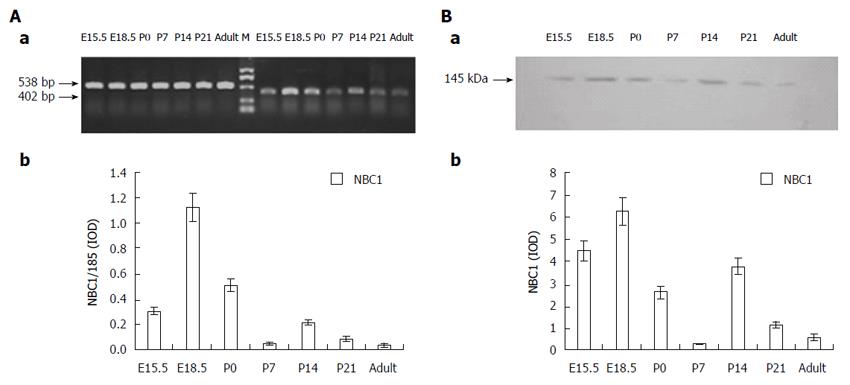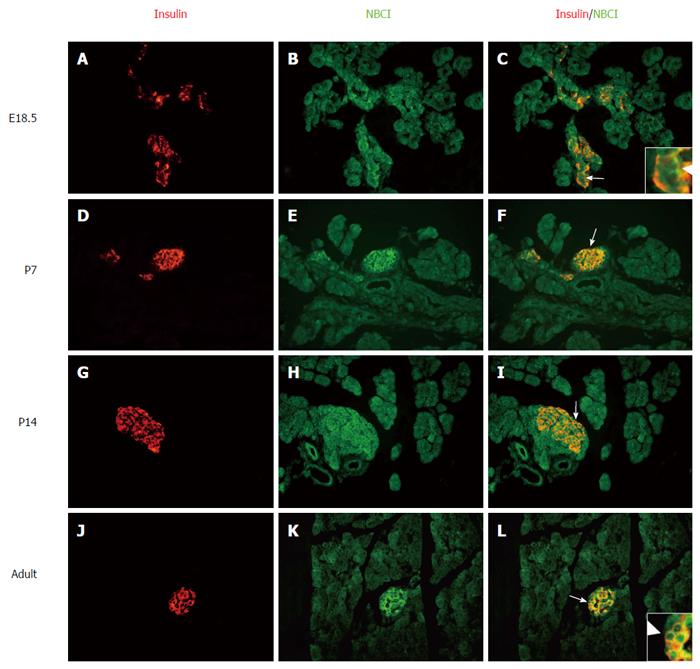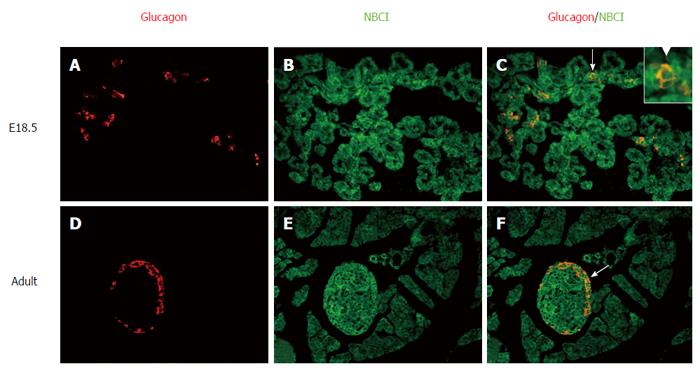Copyright
©The Author(s) 2016.
World J Gastroenterol. Nov 21, 2016; 22(43): 9525-9533
Published online Nov 21, 2016. doi: 10.3748/wjg.v22.i43.9525
Published online Nov 21, 2016. doi: 10.3748/wjg.v22.i43.9525
Figure 1 NBC1 mRNA expression at different developmental stages of rat pancreas measured by reverse transcription polymerase chain reaction (A) and analysis of Western blot data delineating NBC1 expression in different developmental stages of rat pancreas (B).
A: From E15.5 to adult rat, NBC1 expression in pancreas shows a biphasic expression pattern with high expression at E18.5 and P14 but low expression at P7 and adult rat. M: Marker (a); NBC1 expression profile was analyzed and normalized by 18S rRNA (b); B: The data reveals similar bands with molecular weight of about 145 kDa in samples from E15.5 to adult rat. The position of molecular weight markers are indicated on the left (a); The expression pattern of NBC1 is dynamic during rat pancreas development (b). We performed densitometric analysis of each band in all pancreatic sample lanes using the Syngenetool gel analysis software. Results are expressed as the IOD (integral optic density) of single bands in each sample. Values presented are means ± standard deviation of 3 determinations. The level of NBC1 was high at embryonic day (E)18.5 and postnatal day (P)14, but low at P7 and adult stages.
Figure 2 Localization of NBC1 and amylase determined by immunofluorescence detection in different developmental stages of rat pancreas.
Labeling of NBC1 antibodies was detected with an FITC (green)-labeled secondary antibody. Labeling of amylase was detected with a CY3 (red)-labeled secondary antibody on the same section. The overlap of NBC1 (green) and amylase (red) labeling creates orange color. NBC1 positive cells can be detected in pancreas sections at all time points tested. Specific NBC1 immunostaining is present at the basolateral membrane of acinar cells (I, arrow) and the plasma membrane of β cells (F, arrow). NBC1 positive cells make up a widespread proportion of the total cells at E18.5 (A-C) and there is an overlap between the NBC1 positive cells and cells marked with antibodies against amylase in pancreas of E18.5 (arrow). NBC1 positive messages decline to a low but detectable level in acinar cells in adult rat comparing with that of β cells, which apparently are strong positive signals (L, arrow). All of the primary magnifications are × 400. Insets, higher magnifications of the areas indicated by arrow in embryonic day (E)18.5, postnatal (P)7 and P14.
Figure 3 Localization of the NBC1 and insulin determined by immunofluorescence detecting in different developmental stages of rat pancreas.
Labeling of the NBC1 antibodies was detected with an FITC (green)-labeled secondary antibody. Labeling of insulin was detected with a CY3 (red)-labeled secondary antibody on the same section. The overlap of NBC1 (green) and insulin (red) labeling creates orange color. Strong staining for NBC1 is seen in the developing islets at all tested time points, which dominantly colocalizes with insulin positive β cells at the sides of the plasma membrane (arrows). All of the primary magnifications are × 400. Insets, higher magnifications of the areas indicated by arrow in embryonic day (E)18.5 and adult rat. P: Postnatal day.
Figure 4 Localization of the NBC1 and glucagon determined by immunofluorescence detection in pancreas of embryonic day 18.
5 and adult rat. Labeling by the NBC1 antibodies was detected with an FITC (green)-labeled secondary antibody. Labeling of glucagon was detected with a CY3 (red)-labeled secondary antibody on the same section. The overlap of NBC1 (green) and glucagon (red) labeling creates orange color. NBC1 positive cells and glucagon positive cells can be detected in two pancreas sections tested. Obviously, the two proteins are predominantly colocalized in embryonic day (E)18.5 and adult rat (arrows). All of the primary magnifications are × 400. Insets, higher magnifications of the areas indicated by arrow in E18.5.
- Citation: Cao LH, Xia CC, Shi ZC, Wang N, Gu ZH, Yu LZ, Wan Q, De W. Na+/HCO3- cotransporter is expressed on β and α cells during rat pancreatic development. World J Gastroenterol 2016; 22(43): 9525-9533
- URL: https://www.wjgnet.com/1007-9327/full/v22/i43/9525.htm
- DOI: https://dx.doi.org/10.3748/wjg.v22.i43.9525












